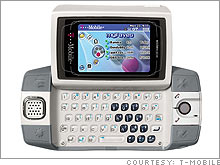Does the Sidekick still have punch?The Sidekick is the BlackBerry of the 18-to-34 demo. But how long can it stay cool?(Business 2.0 Magazine) -- What phone has starred in rap videos, appeared on the David Letterman Show and been spotted in the hands of hotel heiress Paris Hilton? The T-Mobile Sidekick, of course. Thanks to clever marketing, the swivel-screen device has achieved cult status among celebrities and, more importantly, the 18-to-34-year-old demographic it's aimed at.
But it's about to face its ultimate test this summer, as it goes up against the Apple (Charts, Fortune 500) iPhone and other sleek new devices. And it's making a risky bet on the Sidekick iD, a cheaper phone with fewer features. For T-Mobile USA, the American arm of Deutsche Telekom's (Charts) wireless business, the Sidekick has become a crucial part of its phone lineup. The Seattle-based carrier sold an estimated one million Sidekicks last year alone, thanks in part to its continuous introduction of new designs. T-Mobile has already brought out ten different versions of the Sidekick, including five special editions produced in collaboration with celebrities and fashion labels. But the new Sidekick iD, introduced last week, is nothing fancy. It can be had for as little as $99 with a two-year contract - less than half the price of the Sidekick 3. It lacks a built-in camera, MP3 player, and Bluetooth. And unlike other competing phones, it doesn't have video features or the ability to connect to broadband-speed 3G wireless networks. Nevertheless, the iD, like previous devices, is drawing celebrity buzz, and it has the instant-messaging and Web features that have proved most important to Sidekick users. "The Sidekicks are positioned much like a new pair of basketball shoes are," says Todd Kort, an analyst with technology research firm Gartner. "It's a unique device because it's uniquely positioned by T-Mobile. The Sidekick doesn't have much in the way of multimedia. But it is an extremely easy-to-use communication device." If celebrity endorsement is what's gotten the Sidekick into the hands of its target demographic, it's the device's ease-of-use that's kept it there. Five years after the initial launch of the phone, which runs on software from Palo Alto startup Danger and is manufactured by electronics giant Sharp, Kort says Sidekick sales are still going strong. With an LCD screen that flips around 180 degrees to reveal a full QWERTY keyboard, the iD is tailor-made for instant messaging, texting and emailing, just like previous Sidekicks. Flip the screen back on to the keyboard, and the Sidekick is compact enough to stay comfortable for making calls. And while the iD may not feature high-speed connectivity, it's fast enough to pull up popular social-networking sites like MySpace and Facebook. "We thought the [Web browser] would be geared for entertainment, but an overwhelming majority of users are using it to stay connected as well," says John Clelland, T-Mobile's VP of marketing. According to T-Mobile, more than 30 percent of all Web pageviews on the Sidekick are to MySpace.com. What's more, the average T-Mobile Sidekick customer sends or receives more than 3,000 instant messages per month - well above the average for other phones the carrier sells. Still, despite the phone's obvious success and its current popularity, it could run into slowing sales down the road. Motorola's (Charts, Fortune 500) recent woes are a cautionary tale for any wireless company betting on a single hot model. Riding the wave of a big consumer hit like Motorola's Razr for too long can take its toll. And with big growth projected for features like live TV on cell phones, T-Mobile may be missing out on future trends, even as it capitalizes on consumers' enthusiasm today for instant messaging and social networking. At some point, all the celebrity endorsements in the world won't sell a phone that can't deliver the features people want. When wireless video takes off, T-Mobile needs to be ready with an offering that can compete with the music- and video-playing iPhones of the world. "Eventually, they're going to start looking like they're way behind," says Gartner analyst Kort. For now, though the Sidekick and T-Mobile fit each other well. The carrier is well behind rivals like Sprint Nextel (Charts, Fortune 500), Verizon (Charts, Fortune 500), and AT&T (Charts, Fortune 500) in upgrading its network to 3G, so selling a video-enabled Sidekick now would be pointless. Next year, when the company rolls out high-speed cellular services, would be the earliest we could expect to see a video-playing Sidekick. But T-Mobile's Clelland says at this point the company has no plans to add multimedia functions, despite the upcoming network upgrade. "The core notion of the Sidekick is that social people like to stay connected," says the VP. "We focus on communication, and that is the area we'll continue to innovate on at this point." For the moment, it appears the lack of advanced features won't hurt the Sidekick's iconic image. Indeed, at the recent launch party for the iD, the phone found its way into the hands of ousted American Idols, porn star Jenna Jameson and yes, Paris Hilton. "All of the new Sidekicks are met with the same kind of response people give to hot new cars," says Clelland. "It just looks cool." Michal Lev-Ram, a staff writer for Business 2.0 Magazine, blogs daily about the wireless industry. _________________________________ |
Sponsors
|

